As mentioned earlier, astronomers know of no evolutionary connection among the various types of galaxies in the Hubble classification scheme. How then did those different galaxies come into being? To address this question, we must understand how galaxies formed. Unfortunately, the theory of galaxy formation is still very much in its infancy, and no definitive answers yet exist. Do we understand galaxy formation as well as, say, star formation? The answer is a resounding no! The theory is presently unable to answer completely even a basic question such as why spirals and ellipticals exist at all; it certainly cannot predict the different evolutionary tracks that galaxies may take.
There are several good reasons for our lack of understanding of galaxy formation: galaxies are much more complex than stars, they are harder to observe, and the observations are harder to interpret. We have only a partial understanding, and no observations, of the conditions in the universe immediately preceding galaxy formation, quite unlike the corresponding situation for stars. (Sec. 18.5) Finally, whereas stars almost never collide with one another, with the result that single stars and binaries evolve in isolation, galaxies may suffer many collisions and mergers during their lives (see Interlude 24-1), making it much harder to decipher their pasts. Yet despite all these difficulties, some general ideas have begun to gain widespread acceptance, and we can offer a few insights into the processes responsible for the galaxies we see.
The seeds of galaxy formation were sown in the very early universe, when small density fluctuations in the primordial matter began to grow. For now, let us begin our discussion with these "pregalactic" blobs of gas already formed. The masses of these fragments were quite small—perhaps only a few million solar masses, comparable to the masses of the smallest present-day dwarf galaxies, which may in fact be remnants of this early time. So where did the larger galaxies we find today come from? The key point in our current understanding is the realization that galaxies grow by repeated mergingof smaller objects, as illustrated in Figure 24.23. Contrast this process with that of star formation, in which a large cloud fragments into smaller pieces that eventually become stars. (Sec. 19.2)
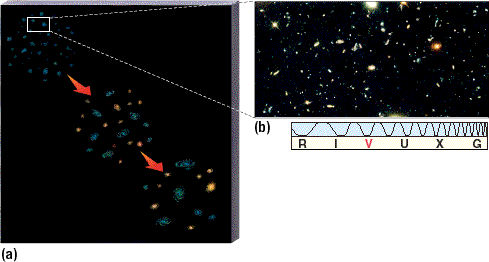
Figure 24.23 (a) The present view of galaxy formation holds that large systems were built up from smaller ones through collisions and mergers, as shown schematically in this drawing. (b) This photograph, one of the deepest ever taken of the universe, provides "fossil evidence" for hundreds of galaxy shards and fragments, up to 5000 Mpc distant.
Theoretical evidence for this scenario is provided by computer simulations of the early universe, which clearly show merging taking place. Further strong support comes from recent observations that indicate that galaxies at large distances from us (well over 2000 Mpc away, meaning that the light we see was emitted more than 6 billion years ago) appear distinctly smaller and more irregular than those found nearby. Figures 24.23b and 24.24 show some of these images, as does the chapter opening image. The vague bluish patches are separate small galaxies, each containing only a few percent of the mass of the Milky Way Galaxy. Their irregular shape is thought to be the result of galaxy mergers; the bluish coloration comes from young stars that formed during the merger process.
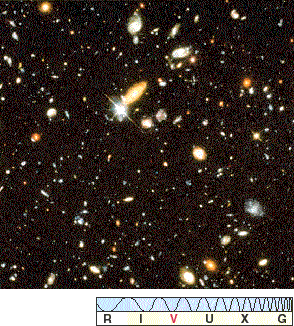
Figure 24.24 Numerous small, irregularly shaped young galaxies can be seen in this very deep optical image. Known as the Hubble Deep Field, this image, made with a total exposure of approximately 100 hours, captured objects as faint as 30th magnitude. Redshift measurements (see Section 24.5) indicate that some of these galaxies lie thousands of megaparsecs from Earth. Their size, color, and irregular appearance support the theory that galaxies grew by mergers and were smaller and less regular in the past. The field of view is about 1' across.
Analysis of Figure 24.23 reveals a group of 18 gigantic "star clusters," all lying in the same region of space, some 600 kpc across, about 3000 Mpc from Earth (see Section 24.5 for more on how such large distances are measured). The 18 rich star clusters—far larger than the conventional open and globular clusters seen in nearby galaxies, yet smaller than typical galaxies like our own—are the small bluish blobs toward the upper left quadrant of the figure. They are shown in more detail in Figure 24.25; each frame is a small part of the larger image, spanning about 1/10 the size of the Milky Way Galaxy. Each blob seems to contain several billion stars spread throughout a distorted spheroid a few hundred parsecs in diameter—just about the size and scale expected for pregalactic fragments. Their decidedly bluish tint suggests that active star formation is already under way. We see them as they were nearly 10 billion years ago, apparently poised to merge into a galaxy-sized object. If this interpretation is correct, then these images lend strong support to the "bottom-up" view of galaxy formation.
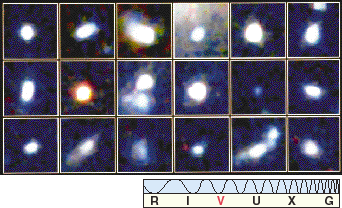
Figure 24.25 Enlargements of selected portions of Figure 24.23(b) reveals rich (billion-star) "star clusters," all lying within a relatively small volume of space (some 600 kpc across). Their proximity to one another suggests that we may be seeing a group of pregalactic fragments about to merge to form a galaxy. The events pictured took place about 10 billion years ago.
If galaxies form by repeated mergers, how might we account for the differences between spirals and ellipticals? The answer is still unclear. One apparently very important factor is just when and where stars first appeared—in the original blobs, during a merger, or later—and how much gas was used up or ejected from the young galaxy in the process. If many stars formed early on and little gas was left over, an elliptical galaxy would be a likely outcome, with many old stars on random orbits and no gas to form a central disk. Alternatively, if a lot of gas remained, it would tend to sink to a central plane and form a rotating disk—in other words, a spiral galaxy would result. However, it is not known what determines the time, the place, or the rate of star formation. For this reason, it is still an open question whether spirals and ellipticals form in basically the same environment or if they tend to form in different places.
We do have some important clues to guide us, though. For example, spiral galaxies are relatively rare in regions of high galaxy density, such as the central regions of rich galaxy clusters. Is this because they simply tended not to form there, or is it because their disks are so fragile that they are easily destroyed by collisions and mergers, which are more common in dense galactic environments? Computer simulations suggest that collisions between spiral galaxies can indeed destroy the spirals' disks, ejecting much of the gas into intergalactic space (creating the hot intracluster gas noted in Section 24.3) and leaving behind objects that look very much like ellipticals. Recent observations of interacting galaxies appear to support this scenario. Figure 24.26 shows an example of this phenomenon. Additional evidence comes from the observed fact that spirals seem to be more common at larger distances (that is, in the past), implying that their numbers are decreasing with time, presumably as the result of collisions.
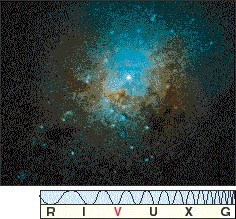
Figure 24.26 The peculiar (Irr II) galaxy NGC 1275 contains a system of long filaments that seem to be exploding outward into space. Its blue blobs, as revealed by the Hubble Space Telescope, are probably young globular clusters formed by the collision of two galaxies.
However, nothing in this area of astronomy is clear cut. We know of numerous isolated elliptical galaxies in low-density regions of the universe, which are hard to explain as the result of mergers. Apparently some, but not all, ellipticals formed in this way.
A related, and very important, question is: When did galaxy formation stop? Astronomers are divided on this issue. Some maintain that there was a fairly well defined time in the past—given by the age of the globular clusters in our own Galaxy, for example—by which most formation was over. Others point out that many galaxies show evidence of mergers and the accumulation of smaller satellite galaxies over an extended period of time—even up to the present day. These astronomers suggest that the many galaxy interactions we observe today (see Interlude 24-1) are just part of the same process begun when the first fragments merged. In this view, galaxy formation is still occurring today. In either case, astronomers have ample evidence that galaxies evolve in response to external factors, even long after formation.
We now know that spiral galaxies have huge, invisible dark halos surrounding them, and we strongly suspect that all galaxies have similar halos. Consider two galaxies orbiting each other—a binary galaxy system. As they orbit, the galaxies interact with each other's halos, one galaxy stripping halo material from the other by tidal forces. The freed matter is either redistributed within a common envelope or is entirely lost from the binary system. This interaction between the halos changes the orbits of the galaxies, which tend to spiral toward each other, eventually merging. If one galaxy of the pair happens to have a much lower mass than the other, the process is colloquially termed galactic cannibalism. Such cannibalism may explain why supermassive galaxies are often found at the cores of rich galaxy clusters. Having dined on their companions, they now lie at the center of the cluster, waiting for more food to arrive. Figure 24.27 is a remarkable combination of images that has apparently captured this process at work.
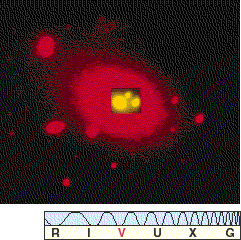
Figure 24.27 This computer-enhanced, false-color composite optical photograph of the galaxy cluster Abell 2199 is thought to show an example of galactic cannibalism. The large central galaxy of the cluster (itself 120 kpc along its long axis) is displayed with a superimposed "window." (This results from a shorter time exposure, which shows only the brightest objects that fall within the frame.) Within the core of the large galaxy are several smaller galaxies (the three bright yellow images at center) apparently already "eaten" and now being "digested" (that is, being torn apart and becoming part of the larger system). Other small galaxies swarm on the outskirts of the swelling galaxy, almost certainly to be eaten, too.
Now consider two interacting disk galaxies, one a little smaller than the other but each having a mass comparable to that of the Milky Way Galaxy. As shown in the computer-generated frames of Figure 24.28, the smaller galaxy can substantially distort the larger one, causing spiral arms to appear where none existed before. The entire event requires several hundred million years—a span of evolution that supercomputers can model in minutes.

Figure 24.28 Galaxies can change their shapes long after their formation. In this computer-generated sequence, two galaxies closely interact over several hundred million years. The smaller galaxy, in red, has gravitationally distorted the larger galaxy, in blue, changing it into a spiral galaxy. Compare the result of this supercomputer simulation with Figure 24.2(b), a photograph of M51 and its small companion.
The final frame of Figure 24.28 looks remarkably similar to the double galaxy shown in Figure 24.2(b). Shown there are two galaxies with sizes, shapes, and velocities corresponding very closely to those in the computer simulation. The magnificent spiral galaxy is M51, popularly known as the Whirlpool Galaxy, about 10 Mpc from Earth. Its smaller companion is an irregular galaxy that may have drifted past M51 millions of years ago. Did this smaller galaxy cause the spiral structure we see in M51? Does the model mirror reality? Perhaps. We need more evidence from other galaxies to confirm the accuracy of these and similar simulations. Still, the computer simulation does demonstrate a plausible way in which two galaxies may have interacted millions of years ago and how spiral arms may be created or enhanced as a result.
It now seems that many of the most spectacular changes that occur in galaxies result from interactions with other galaxies. Astronomers have cataloged numerous starburst galaxies, such as the one shown in Figure 24.29, where violent events, possibly a near-collision with a neighbor, appear to have rearranged the galaxy's internal structure and triggered a sudden, intense burst of star formation in the recent past. Such close encounters are random events and do not seem to represent any genuine evolutionary sequence linking all spirals to all ellipticals and irregulars. However, it is clear that many galaxies and galaxy clusters have evolved greatly since they first formed long ago.
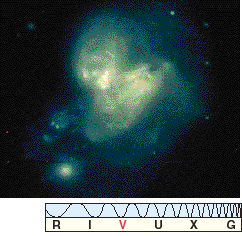
Figure 24.29 This interacting galaxy pair (IC 694, at left, and NGC 3690) shows starbursts now under way in both galaxies—hence the bluish tint. Such intense, short-lived bursts probably last for no more than a few tens of millions of years—a small fraction of a typical galaxy's lifetime.